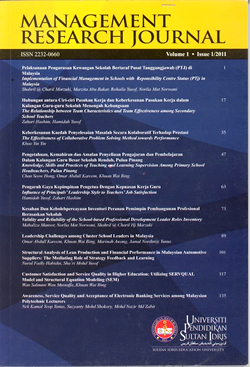The Implementation of Results-Based Performance Management System in Public Elementary Schools
DOI:
https://doi.org/10.37134/mrj.vol10.1.2.2021Keywords:
implementation, results-based, performance, management systemAbstract
The main purpose of this study was to identify the implementation of Results-Based Performance Management System (RPMS) in the public elementary schools in the Schools Division of Ifugao. The Stufflebeam’s Context, Input and Process model was used to identify the implementation of RPMS. The respondents were randomly selected. A total of 466 individuals were the respondents of this study. Survey questionnaire was the main instrument of data collection. The analysis of quantitative data was carried out using a weighted mean and Kruskal-Wallis test to achieve the objectives of the study. Results revealed that the Results-Based Performance Management System (RPMS) as a tool for performance management system in the public elementary schools in the Schools Division of Ifugao was highly implemented. Generally, the implementation of the four phases in RPMS were also highly implemented. Furthermore, there were significant differences in the perceived extent of implementation and the four phases of RPMS. It is then recommended that shared responsibility and agreement both rater and ratee in tracking and recording important events through utilizing the Performance Monitoring and Coaching Form (PMCF) must be consistently observed and properly recorded. Mentoring and giving feedback should be a continuous process and will therefore provide by the rater to improve the work and behavior of ratee. Likewise, strict and consistent compliance of DepEd Order No. 2, s. of 2015 is to be observed in the four phases of RPMS and the role of the Performance Management Team (PMT) ensuring ratees’ performance is properly assessed without any biased must be intensified.
Downloads
References
Aguinis, H. (2009). Performance Management. 2nd Edition. India: Dorling Kindersley.
Civil Service Commission (2012). CSC Memorandum Circular (MC) 06 s. of 2012 (Guidelines for the Establishment and Implementation of Agency Strategic Performance Management System).
Department of Education (2015). DepEd Order No. 2, s. 2015 (Guidelines on the Establishment and Implementation of the Results-Based Performance Management System (RPMS) in the Department of Education), 2015.
Dizon, A. D., San Pedro, A. B., Munsayac, M. M., Padilla, J., & Pascual, M. C. G. (2018). Level of Implementation of the Results-Based Performance Management System in the Department of Education Division of Gapan City, Philippines. International Journal of Research-GRANTHAALAYAH, 6(1),484-503. https://doi.org/10.29121/granthaalayah.v6.i1.2018.1658
Gautam, A. and Jain, S. (2016). “Implementing Performance Management Systems: A Strategic Tool for Human Resource Management.” March 2016 https://www.researchgate.net/publication/306378933
Hamumokola, N. (2013). The Contributions of Performance Management Systems To performance in The Namibian Context’, PhD Thesis, the Faculty of Commerce, Law and Management, University of the Witwatersrand, Johannesburg, September 2013.
Lawler, E.E III. (2003). Rewards Practices and Performance Management system Effectiveness. Organizational Dynamics, 32(4), 396-404 https://doi.org/10.1016/j.orgdyn.2003.08.07
Nankervis, A. R. & Compton, R. L. (2012). Performance management: theory in practice? Asia Pacific Journal of Human Resources, Vol. 44(1), 83-101. https://doi.org/10.1177/1038411106061509
Pradhan, S.K. & Chaudhury, S.K. (2012). A survey on employee performance management and its implication to their relation in OCL India Ltd. Asian Journal of research in social sciences and Humanities, Vol .2, Issue 4, April 2012.
Pulakos, E. D. (2004). Performance management: A roadmap for developing, implementing and evaluating performance management systems. SHRM Foundation: Alexandria,VA. https://d1wqtxts1xzle7.cloudfront.net/52687391/Book_Review_Winning.pdf?1492594755=&response-content-
Razack, S. S and Upadhyay, A. (2017). An exploratory study of Performance Management system and their influence on better performance –a literature review. http://ssrn.com/abstract =2906625 or http://dx.doi.org/10.2139/ssrn.2906625
Sharmistha, B. & Santoshi S. (2011). Employees’ Performance Management in the Manufacturing Sector in India. VSED-IJBMR 1(8) (2011) 496-513.
Stufflebeam, D.L. (1983). The CIPP Model for Program Evaluation. In: Evaluation Models. Evaluation in Education and Human Services, vol 6. Springer, Dordrecht. https://doi.org/10.1007/978-94-009-6669-7_7





